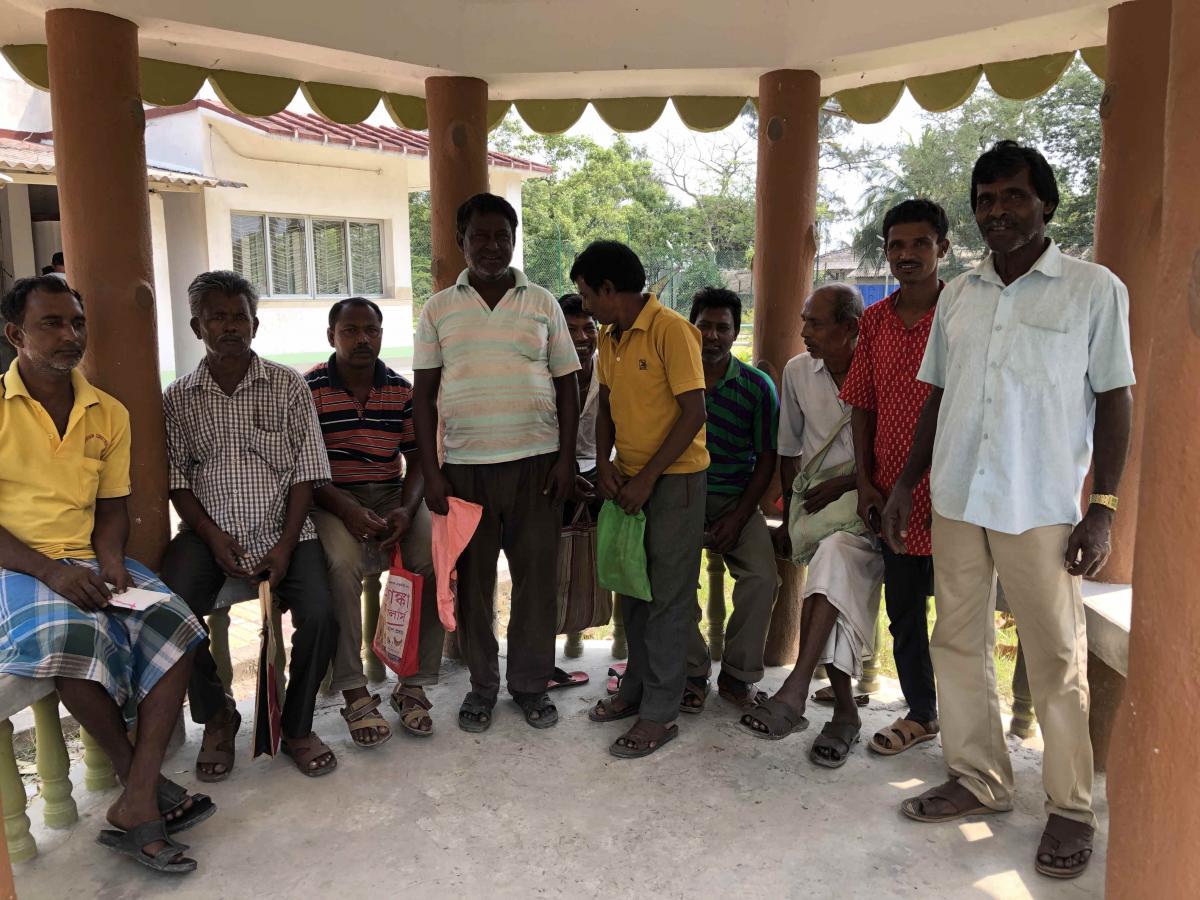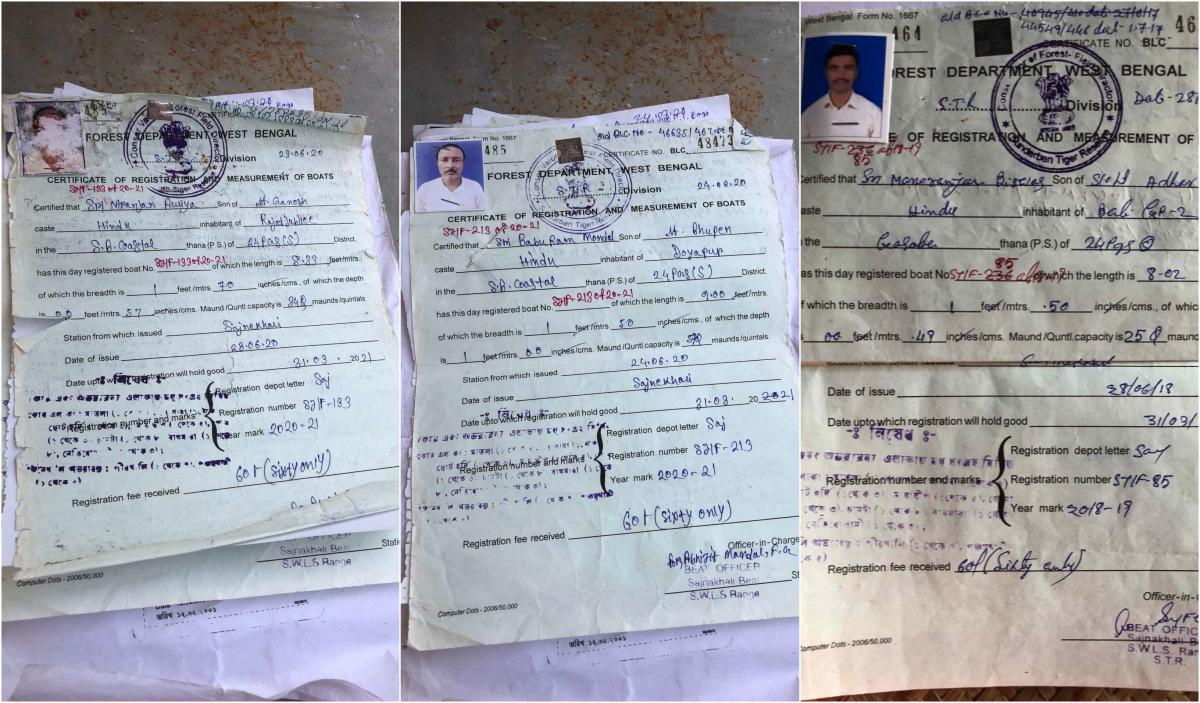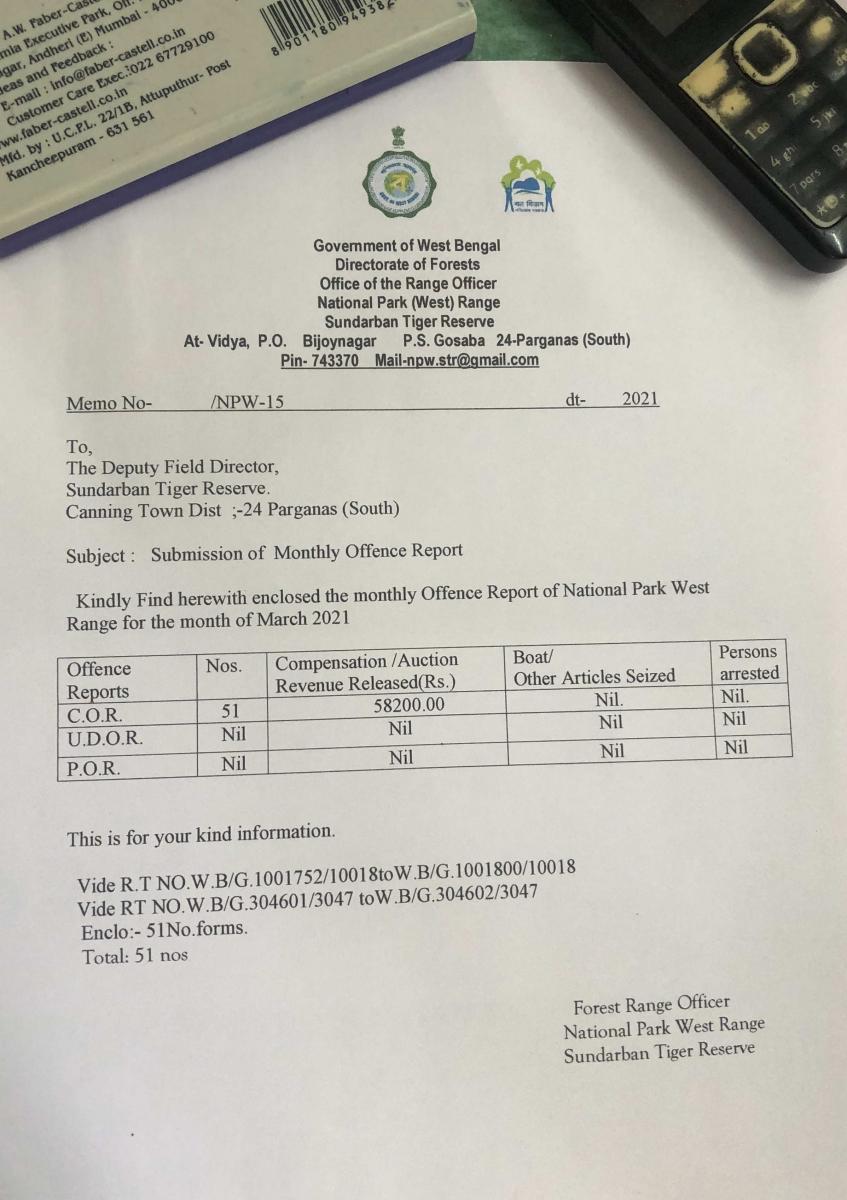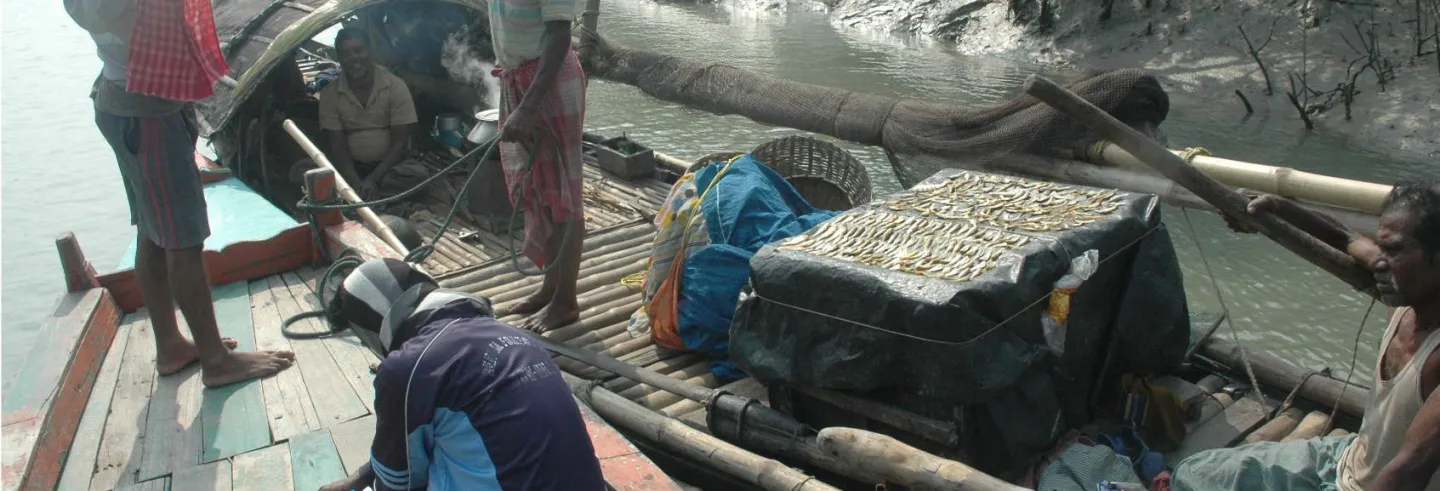One hot afternoon in April, outside the range office of the Sajnekhali Wildlife Sanctuary in the Sundarbans, a group of men sat under a concrete structure that provided some shelter from the sun. The men were fishers, crab collectors, and honey collectors from different islands of the region. All of them had come to retrieve their fishing licences that had been confiscated for ‘trespassing’ in the forests.
As we waited, I began talking to these men. The Sundarbans was going through a particularly distressing period. It was still grappling with the widespread devastation to agricultural fields, ponds, homes from the previous year’s super cyclone Amphan. The Covid-19-induced lockdown meant that sources of income had almost vanished overnight and had instigated a form of food insecurity. In April, campaigning for the West Bengal elections had taken place, hastening the second wave of the pandemic. (We would not know it then, but soon to follow, in May, was another cyclone called Yaas, which would exacerbate the distress.) The men explained their woes of not having a source of income, how the forests had become out of bounds and how Amphan had destroyed homes and fish in their ponds.
But for many of them, the cyclone had receded in their memory. To my surprise, what I encountered more prominently, and a theme to which they returned most emphatically, was a litany of complaints against a piece of paper: their fishing licences.
The injustices of the system of Boat Licence Certificates (BLCs), required to legally fish in the ‘buffer area’ of the forest, have been highlighted by several activist groups and unions.
Not a single fisher present had a licence in his name. Each of them had rented the licence for extortionate sums of money from ‘big men’ and brokers who did not live in the region. Even with this rented licence, they were regularly fined and harassed by forest officials. Their boats were deemed to be interloping because the forests opposite their homes had been made out of bounds. All of them had missed a fishing cycle because of the confiscation and fallen deeper into debt.
I had heard all of this before. The injustices of the system of Boat Licence Certificates (BLCs), required to legally fish in the ‘buffer area’ of the forest, have been highlighted by several activist groups and unions and written about in several scholarly articles. 1 Several chapters in Ghosh (2020), including my own chapter, highlight the exploitative nature of the BLCs. Additionally, Priyanka Ghosh’s excellent PhD thesis (2014) also details the illegality encouraged by the BLC regime in the Sundarbans. If an organisation or an individual is unaware of the bureaucratic violence of the "resties", as the certificates are locally called, one can simply assume that they have not spent more than two full days in a Sundarbans village. Nevertheless, the work of conservation in India today is so deeply depoliticised that most conservationists wilfully ignore addressing one of the most pressing concerns of fishers in the region.
Today the Sundarbans is written about with regard to cyclones and climate change. These are important themes. These are forces that have already and will continue to wreak havoc on the lives of residents. Unlike cyclones that blow away the roofs of homes and inundate fields, BLCs are not sensational. Their violence can rarely be captured in photographs. Yet these tattered pieces of paper — unchanged from a century ago — might be the single biggest everyday hazard to the lives of the fishers: on par with tigers, cyclones, and the rise in sea levels.
A colonial forest in contemporary times
The Sundarbans are a mangrove forest with 52 inhabited islands and a population of approximately 5 million people, the majority of whom belong to a variety of lower caste groups. Opposite the inhabited villages are forested islands interspersed by river creeks. This is one of the most biodiverse spots on earth, with hundreds of species of birds, fish, and plants, apart from being home to the Bengal tiger.
From a ‘wasteland’, the Sundarbans became a frontier for revenue extraction by the British Raj. It was only as recently as 1987 that the region […] came to be regarded as a natural wonder of the world.
Today a conservation hotspot, the Sundarbans was a region not too long ago conceived in colonial records as a ‘sodden wasteland’ with an ‘inscrutable geography where tigers were a menace to be exterminated’ (Hunter 1875). Over the course of a century, the forest went through radical changes in how it was valued, a history that has been documented in detail by anthropologists Annu Jalais (2010; 2007), Amites Mukhodapdhyay (2016), and Aditya Ghosh (2017). From a ‘wasteland’, the Sundarbans became a frontier for revenue extraction by the British Raj. It was only as recently as 1987 that the region was proclaimed as a UNESCO World Heritage Site and came to be regarded as a natural wonder of the world.

Independent India’s First Working Plan for the Sundarbans, for the period of 1949-59, set out very broad principles for governance of the region. But the crisscrossing rivers and forests of the Sundarbans remained largely ungoverned by an understaffed forest department. In fact, it was commonplace into the 1970s for villagers to hunt deer with the awareness of forest rangers, even sharing a large chunk of the meat with them. Timber logging in the Sundarbans ended only in the early 2000s. Clearly, in the early decades after Independence, even the post-colonial forest department did not see the Sundarbans or its animal inhabitants as a forest to be ‘saved’.
This would change at an almost dizzying pace. In the late 1960s, as wildlife numbers in India dwindled due to poaching, several of the country’s elite hunters ‘hung up their rifles’ and began to advocate the cause of conservation. Lobbying by conservationists and a receptive Prime Minister Indira Gandhi, the ‘saviour of tigers in India,’ culminated in Project Tiger, the 1973 creation of nine inviolate tiger reserves, including the Sundarbans.
This zoning of the forest, supported by the conservation lobby, converted swathes of the forest, often directly in front of the homes of fishing communities, as out of bounds to them.
Meanwhile, the wider conservation movement successfully saw through the passage of the Wildlife Protection Act of 1972. Pursuant to the act, the Sundarbans was divided into three parts: a large core area, where, in theory, no human activity is permitted; a sanctuary area for tourists and the tiger; and a buffer area, where fishers and collectors of crabs and honey can seek a legal livelihood from the jungle. This zoning of the forest, supported by the conservation lobby, converted swathes of the forest, often directly in front of the homes of fishing communities, as out of bounds to them.
Today, the Sundarbans is a forest in the 21st century. Camera-traps are set up for tiger censuses and drones and e-patrolling apps “militarize green spaces” (see Lunstrum 2014; Duffy 2014). Visitors take luxury cruises to enjoy ‘pristine’ nature. In several other significant ways though — especially those that deal with the daily lives of fishing communities — the forest continues to be set in a colonial epoch. In the genealogy of the forest from wasteland to wonderland, from scientific forestry that kept local communities out of the forest to conservation and protection which now plays the same role, the Boat Licences continue to be a remnant of the British administration’s ‘licence-permit raj’ that no subsequent post-colonial government has been able to undo.
The Boat Licence Certificates
The history of BLCs is murky. The earliest traceable record is from 1923, where under British governance, a “Certificate of Registration and Measurement of Boats” was given to boats transporting timber from the forest. These licences certainly existed earlier, but the West Bengal Forest Department does not have details and feigns cluelessness. Either the older records were destroyed, or as some bureaucrats claim, all prior paperwork is in offices in the Khulna district in present-day Bangladesh.
There are just 924 active BLCs in existence for the nearly 140,000 fishers in the region. No one, least of all the Forest Department, seems to know when the number of BLCs was last revised.
These ‘certificates’ are pieces of paper that fishers keep as their most prized possession, wrapped in polythene bags along with their ration card and Aadhaar card. They have rows and columns requiring the exact length, width, depth of the boat, and even its wood carrying capacity in maunds — a unit of measurement in British India. Woodcutting has been entirely banned in the Sundarbans. The maund itself, like other archaic units of measurement, was discarded as a standard of weight in 1956. However, somehow, in what is almost a century, the administration has been unable to reform the administration of boat licences, which have now been refashioned to act as permits for fishing and crab collecting.
There are two major problems with continuing this system of licences. There are just 924 active BLCs in existence for the nearly 140,000 fishers in the region. 2 This estimate has been arrived through the excellent monograph by Santanu Chacraverti (2014, 30), where he refers to the challenges of finding out any official numbers with regard to active fishers. No one, least of all the Forest Department, seems to know when the number of BLCs was last revised. Since demand is more than supply, fishers in the Sundarbans have to rent their licences from BLC owners for what is usually anything from Rs 35,000–50,000 per fishing season.
The vast majority of BLCs are in the names of men and women who do not live in the Sundarbans and are not fishers. Several of them were perhaps fishers 60 or 70 years ago but have since been able to find better livelihood opportunities and have moved away from the Sundarbans and are now living in the outskirts of Kolkata or in small towns such as Canning and Sonakhali. For them, the BLC is a piece of paper that allows them to extort high rents from poor fishers on an annual basis.
Since many fishers cannot afford to rent a BLC, and because there are not enough certificates to go around, today thousands of fishing boats go into the buffer area without the permit.
From the point of view of the fishers, the hiring of the BLC is the first step into a deep vortex of debt. Apart from the cost of procuring a licence, a boat has often to be rented, and provisions and bait for the fishing trip have to be bought. Money has to be set aside for the inevitable fines, for everyone is always ‘trespassing’. The cost of fishing or crab collecting ranges from Rs 1 lakh to 1.5 lakhs for a season lasting nine months.
For households that run on Rs 4,000–5,000 a month, this upfront investment is too large an amount for any three fishers to have lying around idly at home. Money is usually borrowed from a middleman involved in the buying and selling of the catch. Often the BLC too is rented out via the same middleman, who acts as a broker between the owners of BLCs and the actual fishers. Some middlemen may also own fish auctioneering centres. When a fishing boat rents a BLC or takes an advance from such middlemen, the implicit agreement is that the boat must sell the catch to him, regardless of whether others offer better prices.

Since many fishers cannot afford to rent a BLC, and because there are not enough certificates to go around, today thousands of fishing boats go into the buffer area without the permit. These fishers try to hide from Forest Department patrol boats, but when they get caught, they face enormous harassment. Often their fishing nets or crab collecting lines are confiscated.
Paying some money as punishment for entering the inviolate core area can by no means protect the fragile ecosystem.
Interloping into the forest also takes another form. Instead of going to the buffer area, where it is legal to fish with a BLC, many boats go into the ‘sanctuary’ or ‘core area’ of the forests, which are closer to the homes of fishers. The buffer area is far from many of the inhabited islands on the western side of the delta. To reach the area, fishers have to traverse the Matla river and other tributaries where the flow of the water is too strong for their naukas, the fragile, non-motorised, wooden canoes. The Matla is an international waterway between Kolkata and Dhaka, through which large, heavily rusted, and decrepit cargo ships are seen and heard transporting fly ash from India to Bangladesh.
Other risks abound. The mangrove creeks have tigers. The buffer area is too close to the Bangladesh border, where many fishers have been attacked by dacoits or dakaats who seize the catch, fishing equipment, and even take individuals for ransom. For many, paying ransom has been a turning point that pushed them into debt for years.
‘Illegality Incorporated’
‘Illegality’ is incorporated (see Anderson 2014) by the Forest Department into the administration of the Sundarbans. Fishers with a BLC break the laws by going into a zone of the jungle where they are not allowed to legally fish. Foresters repeatedly fine these trespassers If a fisher is caught too many times, his BLC is confiscated. Once the BLC is confiscated the fisher has to go to the Range Office — usually a day’s trip away from the fisher’s village — to try to retrieve the licence. Often the ranger will ask the fisher to come back another day, forcing him or her to miss an entire fishing cycle. Finally, whenever the BLC is returned, a fine must be paid.
Colonial laws understood the fines, officially called as “compounding offences,” as a tax for the wood taken from the forest. Today when timber logging has been banned and the imperative of the Forest Department is conservation, the department conceives of the fines as a deterrent to illegal fishing. This makes no logical sense. Paying some money as punishment for entering the inviolate core area can by no means protect the fragile ecosystem. Everyone in the Forest Department, from rangers to senior-level bureaucrats, knows, as do the fishers, that the fine amounts, though not insignificant, are too small to prevent fishers from “trespassing.”
It is unclear what purpose the system serves, other than to squeeze money out of fishing communities, who also happen to be landless and some of the poorest residents of the Sundarbans islands.
The BLCs themselves have been defended by some senior bureaucrats, who think of the licences as limiting overfishing. While overfishing is certainly a fear, it seems only to be pointed at wooden fishing boats and not the trawlers that abound in the seas. In order to curtail overexploitation of the fish and crab stock of the forests, what is needed is a systematic study of the Sundarbans’ carrying capacity, to determine what might be a sustainable number of fishing boats for each fishing season. If the demand is much more than what is a sustainable form of fishing, then a system of forest use can be devised based on a rotational basis. There are several plausible solutions and alternatives, but none of them are part of the current discourse in the Sundarbans. Narratives of scarcity and accusations of greed are only ever pointed towards poor and landless fishers while the harm done by larger and much more powerful extractive industries is ignored (see Mehtta 2021).
It is unclear what purpose the system serves, other than to squeeze money out of fishing communities, who also happen to be landless and some of the poorest residents of the Sundarbans islands. The official ‘illegal’ status gives the Forest Department free rein to harass the fishers. Every fisher in the Sundarbans is in some way made to feel an interloper as the entire system of fishing is based on a public secret of trespassing. As a result, fishers are forced to into obsequious relationships with the forest rangers, commission agents, and middlemen.
The only time an attempt was made to reform the BLC system was in 2017. Just before he retired, Pradeep Vyas, West Bengal’s Principal Chief Conservator of Forests, tried to reissue BLCs to actual or “genuine” fishers, by cancelling the ones in the name of current “big men”. Vyas, during my meeting with him in 2017, acknowledged the violence of the system and was very keen to change it. However, the issue was so politically charged that the endeavour failed. Those who own BLCs are powerful individuals. They own fish landing centres and auction houses and have deep ties with political party leaders. Their political affiliations and their promise of securing vote banks for politicians protect them from having such a form of rent-seeking being taken away from them. In the end, BLCs continue to be deeply unjust remnants of the colonial period. Opening such an issue is a can of (politically agitated) worms that no one in the government wishes to contend with.
The “boring” work of conservation
The creation of zones of illegality in the Sundarbans, such that every movement of fishers becomes an act of trespassing, is both counterproductive to the goal of conservation and a form of harassment of fishers. In addition, the continuation of the colonial-era Boat License Certificates creates an environment of fear and hostility and plunges fishers into cycles of debt with middlemen and rangers. The injustice of the system is something everyone — including senior bureaucrats, rangers, and national and international conservation NGOs such as the WWF — is aware of. Yet not a single conservation organisation in the region is interested in tackling or engaging with these colonial licences, executed with equal rigour and with the exact units of measurement of British India up until the present.

Conservation organisations in the Sundarbans are busy counting tigers and providing merchandise to ‘save the tiger’. They support, manage, and promote tourism—the detrimental effects of which far exceed the minuscule livelihood opportunities they profess to provide. They are delighted that city people consume the so-called ‘pristine’ nature of the Sundarbans. Several of the organisations believe in community-based conservation and therefore promote ‘alternative livelihoods’ in the form of chicken rearing and goat rearing. However, when it comes to dealing with the colonial licence regime of the BLC — which is distressing not just to the fishers but also for the ecosystem that they are ostensibly keen on preserving — conservation organisations simply ignore the problems.
Conservation in India is deeply depoliticised. In the age of cyclones, rising sea levels , and pandemics, for conservation to work in the Sundarbans, before radio-collaring tigers and operating drones for patrolling, conservationists first need to contend with the excruciatingly boring, bureaucratic, and pedantic work of fixing injustices like those of licences and permits. Until conservation organisations engage with politically contentious issues, they are giving out a ‘licence’ to kill.








